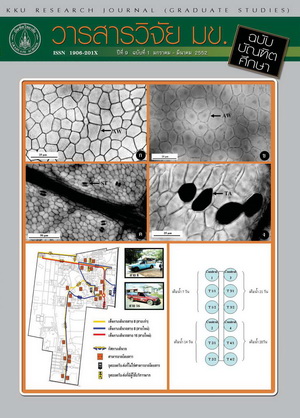กายวิภาคศาสตร์เปรียบเทียบเนื้อเยื่อชั้นผิวใบของพืชวงศ์ไม้ยาง (Dipterocarpaceae) บางชนิดในประเทศไทย (Comparative Leaf Epidermis of Some Dipterocarpaceae in Thailand)
Keywords:
Anatomy(กายวิภาคศาสตร์), Dipterocarpaceae(พืชวงศ์ไม้ยาง), Epidermis(เนื้อเยื่อชั้นผิว)Abstract
ศึกษากายวิภาคศาสตร์เปรียบเทียบเนื้อเยื่อชั้นผิวใบของพืชวงศ์ไม้ยางในประเทศไทย จำนวน 8 สกุล 25 ชนิด ได้แก่ สกุล Anisoptera 2 ชนิด สกุล Dipterocarpus 4 ชนิด สกุล Shorea 7 ชนิด สกุล Vatica 8 ชนิด และสกุล Cotylelobium, Hopea, Neobalanocarpus และ Parashorea สกุลละ 1 ชนิด โดยวิธีการลอกผิวและการทำให้แผ่นใบใส เพื่อค้นหาลักษณะทางกายวิภาคศาสตร์ที่ใช้ในการระบุพืชที่ศึกษา ผลการศึกษาพบว่าลักษณะทางกายวิภาคศาสตร์ที่สามารถนำมาใช้ในการระบุชนิดพืชที่ศึกษา ได้แก่ ชนิดของขนและบริเวณที่พบขน ชนิดของปากใบ การมีหรือไม่มีสารสะสมแทนนินและท่อน้ำมันยางในเนื้อเยื่อชั้นผิว ผลึกรูปดาวหรือรูปปริซึมภายในเซลล์มีโซฟิลล์ และเซลล์หลั่งที่ปลายเส้นใบย่อย นอกจากนี้ยังสามารถใช้ลักษณะดังกล่าวในการแบ่งกลุ่มพืชที่ศึกษาได้ เช่น ชนิดของปากใบสามารถแบ่งพืชออกเป็น 3 กลุ่ม ได้แก่ กลุ่มที่ 1 มีปากใบแบบไซโคลไซติก กลุ่มที่ 2 มีปากใบแบบไซโคลไซติกและเฮกซะ ไซติก และกลุ่มที่ 3 มีปากใบแบบพาราไซติก เป็นต้น อย่างไรก็ตามการแบ่งกลุ่มพืชโดยใช้ลักษณะทางกายวิภาคศาสตร์ไม่สัมพันธ์กับการจำแนกโดยใช้ลักษณะทางสัณฐานวิทยา
The comparative anatomy of leaf epidermis of 25 species in eight genera of Thai dipterocarps: two species of Anisoptera, four of Dipterocarpus, seven of Shorea, eight of Vatica, and one of Cotylelobium, Hopea, Neobalanocarpus and Parashorea respectively, was studied using epidermal peeling and clearing techniques. The aim of the present study was to investigate anatomical characters that are useful for species identification. The results indicated that the anatomical characters considered to be a taxonomically significant character for species delimitation are the distribution and types of hairs, stomatal types, the presence/absence of tannin and resin canals in epidermis, druses and prismatic crystals in mesophyll and secretory cells at the end of veinlets. Moreover, these characters can be used to separate the family into a group. For example, the family can be divided into three groups based on stomatal types; 1) cyclocytic group, 2) cyclocytic and hexacytic group, and 3) paracytic group. The groups based on anatomical characters were, however, not congruent with the groups based on morphological characters.



